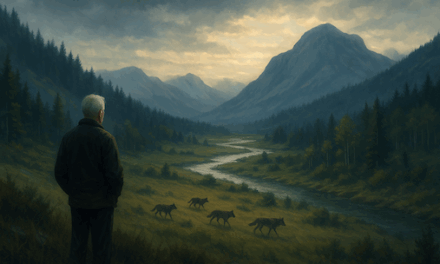The degrowth movement and the maturation framework both recognise that infinite growth on a finite planet is impossible. Both acknowledge we’ve transgressed ecological boundaries and face converging crises. Both call for fundamental transformation of how we organise economic and social life.
But they differ profoundly in diagnosis, psychology, and pathway forward.
In Brief
Growing Up or Scaling Down contrasts the degrowth movement’s call for contraction with a developmental alternative that sees humanity’s challenge not as “scaling down” but as “growing up.” Both perspectives accept that endless economic expansion on a finite planet is impossible. But while degrowth frames change as sacrifice, the maturation framework interprets it as evolution—a shift from adolescent extraction to mature participation. Drawing on history, biology, contemplative traditions, and lived experience, it argues that greed and accumulation are not moral failings but expressions of separation consciousness that can be consciously re-channelled through culture and design. Transformation, then, becomes an act of growth in wisdom rather than reduction in scale: sustaining material sufficiency within relational integrity. The essay invites readers to sense this shift in themselves and in society—a movement from consumption to contribution, and from control toward conscious participation in life’s unfolding whole.
The Shared Recognition
Degrowth deserves credit for stating an uncomfortable truth: the emperor has no clothes. The assumption that GDP must grow every year forever, that productivity gains should accelerate consumption indefinitely, that technology will transcend all physical limits—these are fantasies incompatible with thermodynamics, ecology, and historical evidence.
The degrowth critique accurately identifies how growth-dependent systems create perverse incentives. When pension funds require 7% annual returns, when employment depends on expanding production, when political legitimacy flows from delivering rising consumption—the entire apparatus becomes locked into dynamics that override ecological constraints.
Both frameworks also recognise that this isn’t primarily a technological problem. More efficient solar panels and electric vehicles, while useful, don’t address the deeper pattern if they’re deployed within systems still organised around extraction and expansion.
Where the Paths Diverge
The Diagnosis: Capitalism vs. Consciousness
Degrowth typically locates the problem in capitalism—the specific economic system that emerged in recent centuries and requires perpetual accumulation. The solution, in this view, requires dismantling capitalist relations and replacing them with non-growth-dependent alternatives.
The maturation framework diagnoses the problem as older and deeper: the consciousness trap that symbolic intelligence creates. This trap preceded capitalism by ten thousand years and has manifested across diverse economic systems—slave empires, feudal hierarchies, state socialist regimes, and modern capitalism all exhibit the same underlying pattern of symbolic intelligence overriding ecological constraints.
Historical evidence supports the deeper diagnosis. Luke Kemp’s study of 324 collapsed civilisations spanning five millennia shows the pattern recurring long before capitalism existed. Peter Turchin’s mathematical models reveal “wealth pump” dynamics operating across radically different economic systems. The mechanism isn’t specific to private property or market relations—it’s about any system where symbolic intelligence can create institutional separation from immediate ecological feedback.
This matters because if capitalism is symptom rather than cause, then replacing it with alternative economic systems organised around the same ontological error—treating humans as separate from and superior to nature, imagining intelligence can transcend constraints, structuring institutions divorced from consequences—won’t solve the underlying problem. Soviet central planning, for instance, generated ecological devastation rivalling any capitalist economy.
The Psychology: Sacrifice vs. Channel
Degrowth’s call to “consume less” and “scale down” triggers psychological and political resistance because it frames transformation as sacrifice. Even when degrowth advocates emphasise quality of life over material consumption, the framing remains fundamentally subtractive: less stuff, smaller economy, reduced throughput.
This creates a political impossibility. Governments that can’t deliver growth lose legitimacy. Leaders suggesting voluntary contraction don’t get elected. The democratic processes needed to navigate transition peacefully are captured by the very dynamics that make transition necessary.
The maturation framework reframes the challenge developmentally rather than sacrificially. The biological drive to accumulate excess when scarce resources are available—what contemplative traditions called greed and Adam Smith made central to economics—isn’t a moral failing to condemn or an instinct to suppress. It’s an adaptive evolutionary response that enabled survival and created civilisation’s material achievements.
The challenge isn’t eliminating this drive (impossible) or glorifying it as virtue (destructive). It’s consciously channelling it through cultural structures toward regenerative rather than extractive ends.
This changes everything psychologically. “Growing up” sounds aspirational. “Scaling down” sounds like defeat. The first invites development, the second demands diminishment. The first acknowledges our achievements while calling us to wisdom, the second seems to negate progress itself.
The Historical Evidence: Neither Romanticising nor Despair
Here we must navigate carefully between two traps.
The first trap is romanticising indigenous cultures as universally harmonious and ecologically wise. This is historically false and intellectually dishonest. Luke Kemp’s analysis of 324 collapsed civilisations includes early Goliaths that emerged in Mesoamerica, the Andes, China, and the Middle East—many of them indigenous societies. He explicitly describes these extraction-based hierarchies as “anything but civilised, with war, patriarchy and human sacrifice.”
The Aztec Empire practiced large-scale human sacrifice and extracted tribute from conquered peoples. The Inca Empire built extraction hierarchies sustained by forced labour. Various Mesopotamian kingdoms enslaved populations and waged conquest wars. These weren’t aberrations—they were Goliaths, regardless of their geographic or cultural origins.
The critical distinction isn’t between indigenous and modern, or East and West. It’s between cultures that developed extraction-based hierarchies (Goliaths) and those that maintained complex organisation without doing so.
The second trap is concluding that because some cultures fell into extraction dynamics, all human societies inevitably do. This is equally false.
The historical record shows that specific cultures—including certain indigenous North American confederacies, Pueblo peoples, and various African and Pacific societies—achieved complex social organisation, accumulated knowledge across generations, developed sophisticated technologies, and created rich artistic and spiritual traditions without Goliath dynamics.
They accomplished this through what might be called cultural technology: potlatch ceremonies that prevented accumulation by making status flow from giving rather than hoarding; gift economies where wealth moved through people rather than sticking to them; commons management that shared resources rather than privatising them; jubilee years that periodically reset relationships and redistributed land; usufruct rights that granted use without ownership.
These weren’t naive or primitive arrangements. They were sophisticated institutional structures that channelled the biological accumulation drive sustainably—in some cases for thousands of years, with some continuing to operate today.
The Stockdale Paradox in Historical Time
Admiral James Stockdale survived eight years as a prisoner of war by holding two truths simultaneously: “You must never confuse faith that you will prevail in the end—which you cannot afford to lose—with the discipline to confront the most brutal facts of your current reality, whatever they might be.”
Apply this to the question of transformation:
The brutal fact: Many human societies, across all continents and time periods, developed extraction hierarchies that generated violence, inequality, environmental degradation, and eventual collapse. Some indigenous cultures fell into this pattern. The drive to accumulate exists in all humans. Creating exploitative hierarchies is entirely possible and historically common.
The hopeful fact: Some human societies successfully navigated this challenge. They proved that complex, prosperous, meaningful human life is possible within regenerative constraints. They demonstrated that cultural structures can channel accumulation drives sustainably. The examples exist. They worked. Some still work.
Both facts are true. Hold them together.
The evidence matters not because it shows indigenous cultures were perfect (they weren’t), but because it demonstrates that sustainable cultural organisation is possible. When degrowth critics claim that transformation requires impossible sacrifice of well-being, the historical record provides counterexamples: societies that maintained abundance, developed sophisticated knowledge, and created meaning-rich lives without growth-phase extraction.
What’s unprecedented isn’t the challenge of channelling human drives sustainably—that’s been solved before. What’s unprecedented is attempting it at planetary scale with eight billion people dependent on systems requiring the impossible, with no geographic outside, on a rapidly destabilising climate, within a vanishingly short timeframe.
This is harder than what any previous society faced. But it’s not different in kind. The principles that enabled some cultures to mature can inform how we might.
What Actually Must Change
Both frameworks recognise that current systems must transform. But they differ in what requires changing.
Degrowth typically emphasises economic restructuring: ending GDP growth, redistributing wealth, localising production, reducing consumption especially among the affluent. These changes are necessary—but they risk addressing symptoms while missing the deeper structure.
The maturation framework focuses on four interrelated transformations:
Personal transformation: Cultivating awareness of how our own consciousness participates in separation. Recognising when we’re treating life as problem to solve rather than pattern to participate in. Developing what contemplative traditions call discernment—the capacity to distinguish between wisdom and cleverness.
Here the framework converges remarkably with Buddhist practice. What Buddhism identified 2,500 years ago as tanha (craving/grasping)—the fundamental poison generating suffering—the maturation framework recognises as the biological accumulation drive operating without constraints. What Buddhism calls pratītyasamutpāda (interdependence/interbeing), the framework describes as relational ontology that separation consciousness systematically denies.
The Buddhist insight that the adversarial relationship between human will and natural limits dissolves not because limits disappear but because the desire to override them does—this is precisely what maturation cultivates. Not through moral condemnation of greed, but through practices that reveal how symbolic intelligence creates the illusion of separation in the first place.
Every major contemplative tradition discovered this experientially:
- Buddhist tanha (craving)
- Christian avarice (greed)
- Islamic hirs (acquisitiveness)
- Hindu lobha (greed)
All recognised what the maturation framework now articulates with scientific and historical evidence: that what contemplatives called greed is “the subjective experience of separation consciousness—believing you’re fundamentally alone, must accumulate for security, can find satisfaction through possession.”
The practices these traditions developed—meditation, contemplative inquiry, mindfulness, what Buddhism calls “right relationship”—are sophisticated technologies for the very transformation the maturation framework advocates. They quiet symbolic consciousness temporarily so other forms of intelligence can be heard. They cultivate the shift from grasping to allowing, from resistance to acceptance, from separation to participation.
What’s new isn’t the recognition that consciousness can transform—contemplatives have known this for millennia. What’s new is:
- The convergence of historical evidence (324 documented collapses showing the pattern)
- Mathematical models revealing the mechanisms (wealth pump dynamics)
- Biological understanding (evolutionary psychology of accumulation drives)
- Ecological crisis making transformation urgent at planetary scale with no geographic outside
The maturation framework brings together what were previously separate streams of wisdom: indigenous cultural technologies, contemplative practices, modern scientific understanding, and historical evidence. All converge on the same recognition.
Cultural transformation: Redefining success from accumulation to contribution, from having to giving, from extraction to regeneration. Making status flow from enhancing life rather than controlling it. Honouring elders who model mature participation rather than exiling them to consumption-only retirement. These aren’t policy changes but shifts in what we collectively value—what Buddhism would recognise as cultivating kusala (wholesome states) rather than akusala (unwholesome ones).
Institutional transformation: Shutting down wealth pumps through distributed rather than concentrated power. This includes worker organising rights, progressive taxation preventing extreme accumulation, stakeholder governance, cooperative ownership, and economic structures that align success with collective flourishing. The goal isn’t perfect equality but fairness—ensuring productivity gains are shared rather than captured by those positioned to extract.
Relational transformation: Restoring feedback between decisions and consequences. This means embedding decision-makers within systems they affect, operating on timescales matched to ecological dynamics, and ending the separation that lets some people profit from extraction while others bear the costs. What contemplatives practice individually—recognising interdependence directly—must be encoded into institutional structures.
Notice these aren’t primarily economic interventions. They’re changes in how we organise participation, value contribution, distribute power, and maintain accountability. Economics follows from these deeper patterns.
The Abundance Question
Perhaps the most significant difference concerns abundance itself.
Degrowth tends to emphasise limits, constraints, and the necessity of accepting less. This is true in one sense—we cannot maintain current rates of material and energy throughput without catastrophic consequences. Global North consumption levels are unsustainable and unjust.
But the maturation framework maintains that we can sustain abundance while building cultural constraints that redirect our drives regeneratively. The goal isn’t returning to scarcity (which would mean suffering and death) but maintaining material sufficiency within relational integrity.
Indigenous examples demonstrate this possibility. Complex societies sustained abundant, meaningful lives for millennia without growth-phase extraction. They didn’t achieve this through poverty or deprivation but through sophisticated cultural technology that channelled drives differently.
Modern renewable energy, when organised through regenerative rather than extractive systems, could provide material abundance sufficient for dignified lives globally. The technological capacity exists. What lacks is the cultural, institutional, and relational structures to deploy it wisely.
This is why the maturation framework insists: not abandoning what we’ve built, but evolving how we build. Not retreating from complexity, but learning to participate within it. Not going back, but growing up.
The Political Dimension
Degrowth faces a profound political problem: it asks people who’ve been taught that progress means growth to voluntarily choose contraction. In democracies, this is a non-starter. In authoritarian systems, it provides justification for oppression without solving underlying dynamics.
The maturation framework doesn’t escape political difficulty—transformation is never comfortable or smooth. But it offers more viable framing: we’re not being asked to sacrifice but to mature. We’re not diminishing human possibility but expanding it beyond the adolescent pattern of boundary-testing and limit-denial.
Every healthy developmental system faces the threshold where growth-phase dynamics must either transform or collapse. Adolescence isn’t bad—it’s necessary. The drive to explore, to test boundaries, to establish independence: these are features, not bugs. But healthy systems don’t remain adolescent.
Framing our crisis developmentally rather than economically acknowledges what we’ve achieved through the growth phase while calling us to the next stage. It honours agriculture, cities, science, technology, art—the real accomplishments of symbolic intelligence—while recognising they’ve reached the limits of sustainable expression through extraction-based systems.
The Time Question
Both frameworks acknowledge urgency. We’re not approaching crisis—we’re inside it. By Turchin’s models, the wealth pump dynamics are fully engaged. By Kemp’s historical analysis, we’re living inside the first truly planetary Goliath. By biological understanding, we’re operating with scarcity override at global scale.
The window for conscious maturation is narrowing. Developmental thresholds don’t stay open indefinitely. Miss them, and systems reorganise around damage rather than wisdom.
But here’s where evidence provides grounds for engagement rather than despair: societies have successfully navigated this challenge. Post-World War II social democracy in Europe, New Deal reforms in America, Costa Rica’s redirection after 1948—all demonstrate transformation is possible when enough people choose it.
Cultural evolution moves far faster than biological evolution. The eukaryotic partnership that enabled complex life took hundreds of millions of years. Cultural transformations can cascade in decades when conditions align. Christianity spread from twelve disciples to empire-transforming movement in three centuries. Scientific method reshaped human knowledge in generations. Democratic ideals spread globally within lifetimes.
We have more knowledge, more global communication, more awareness of systemic dynamics than any previous generation. We’ve learned from historical examples what works and what fails. Societies have “become more resilient to these forces in recent centuries, which offers grounds for hope.”
An Invitation to Dialogue
Before concluding, let me address what might seem like a missed opportunity in this essay: it compares maturation and degrowth rather than exploring how they might inform each other.
That comparison was necessary to clarify differences. But the deeper question is dialogical: What might degrowth look like through a developmental lens? And what might the maturation framework learn from degrowth’s unflinching confrontation with limits?
Degrowth advocates have done crucial work making visible what the growth paradigm systematically obscures: that infinite expansion on a finite planet is thermodynamically impossible, that technological solutions within extractive systems amplify the underlying problem, that meaningful change requires confronting power structures rather than optimising around them.
The maturation framework offers something complementary: a way to understand why humans keep building growth-dependent systems despite their predictable failures, and how cultural structures might channel our biological drives differently. It reframes the challenge from economic reform to developmental transition—which might make transformation psychologically and politically more viable.
But these aren’t competing approaches. They’re different lenses on the same crisis, arising from different disciplinary traditions and asking different questions. The most productive path forward likely involves both degrowth’s critical analysis of growth dependence and maturation’s developmental understanding of what enables transformation.
I invite degrowth thinkers into this conversation: How might your insights about limits, power, and extraction inform our understanding of what maturation requires? What does it mean to “grow up” when confronted with biophysical boundaries? How might we frame necessary contraction as developmental rather than sacrificial?
These questions deserve exploration together, not in opposition.
The Felt Experience of Maturation
The essay so far has operated primarily at the conceptual level—ideas about drives, systems, and transformation. But maturation isn’t just intellectual recognition. It has a phenomenology, a felt sense that people can recognise in their own experience.
What does the shift from extraction to participation actually feel like in daily life?
Consider the moment when you stop measuring your worth by what you’ve accumulated and begin sensing it through what you contribute. There’s often a palpable release—not loss, but relief. The exhausting performance of having enough, being enough, proving enough gives way to something simpler: showing up, participating, tending what needs tending.
Or notice what happens when you shift from viewing a problem to solve to recognising a pattern you’re already part of. The hypervigilant scanning relaxes slightly. You’re no longer standing outside trying to fix things, but inside participating in their becoming. The boundary between you and the situation softens—not dissolving into confusion, but becoming more permeable, more responsive.
These aren’t abstract philosophical states. They’re embodied experiences available in ordinary moments:
In conversation: You’re at dinner with a friend who’s upset about something. The extraction mode listens for your turn to speak, mentally composing your response, subtly competing to have the better story or wiser insight. The participation mode pauses before responding. Really hears. Asks a follow-up question that lets the friend go deeper. Notice the physical difference: extraction keeps your chest tight, your mind racing ahead. Participation lets you settle, lets silence be okay, creates space where genuine understanding can emerge.
In a grocery store: You reach for the cheapest tomatoes—pale, tasteless, grown in industrial monoculture thousands of miles away. The extraction logic is pure efficiency: lowest price, maximum convenience. Or you choose tomatoes from a local farm you’ve visited, grown without chemicals, harvested yesterday. They cost more. But you’re participating in a relationship—with soil, farmers, seasons, your own body’s nourishment. You can taste the difference. One transaction disappears instantly. The other connects you to place and process.
At work: A colleague proposes an idea that makes your own look less impressive. Extraction mode immediately defends territory, finds flaws in their proposal, positions your approach as superior. This generates a familiar tightness—the exhausting performance of being right, being valuable, being indispensable. Participation mode recognises that their good idea and yours aren’t competing—they might strengthen each other. You ask genuine questions about how they could combine. The relief is palpable. You’re creating value together rather than extracting recognition for yourself.
With a child crying: The extraction approach treats tears as a problem to solve—distract, fix, make it stop so you can return to what you were doing. The participation approach recognises tears as communication—something needs tending. You sit with the child. Let them feel what they’re feeling. Your presence doesn’t fix anything, but it transforms the experience of distress from isolation to connection. Both the child and you can sense the difference.
In your neighbourhood: You notice the street needs the sidewalk repaired. Extraction thinking says: not my property, not my problem, call the city and complain. Participation thinking organises neighbours to fix it together—sharing tools, labour, the satisfaction of improving shared space. One approach leaves you isolated and resentful. The other builds relationships and competence simultaneously.
Facing winter darkness: Extraction mode fights seasonal rhythms—bright lights to deny the dark, heated greenhouse vegetables to deny the cold, constant productivity to override the body’s call to rest. Participation mode recognises winter’s invitation—longer sleep, heartier foods that store well, slower pace, inward attention. You align with the season rather than resisting it. Your body relaxes into the rhythm that evolved over millions of years.
These aren’t always comfortable shifts. Maturation often involves giving up consoling fantasies—that you can control outcomes, that success means escaping limits, that your worth depends on standing above others. There’s real grief in these releases. The person who defined themselves by career advancement feels genuine loss when they shift to valuing contribution over position. The parent who prided themselves on fixing everything for their children feels vulnerable learning to witness struggle without rescuing.
But there’s also a specific quality of rightness that comes from aligning with how things actually work. Your nervous system recognises the difference between forcing and flowing, between overriding and participating. The first generates a particular kind of exhaustion—the chronic tension of maintaining control, the vigilance required to defend position, the depletion that comes from treating relationship as transaction. The second, even when difficult, feels sustainable. You sleep better. Meals taste better. Conflicts resolve more easily because you’re not performing superiority.
This is what indigenous elders mean when they speak of “good mind” or “right relationship”—not moral superiority but operational fit with reality. And it’s what contemplative practitioners recognise as the shift from grasping to allowing, from resistance to acceptance, from separation to participation.
Small practices for noticing:
Each day this week, pause once in conversation and listen longer than feels comfortable. Afterward, write one line: “Today I noticed participation when…” At week’s end, reread those seven moments. What pattern emerges?
Before purchasing something, pause and ask: “Does this choice strengthen extraction or participation?” Not to judge yourself harshly, but to notice. You’re embedded in systems designed for extraction—you can’t opt out completely. But you can become more conscious of when you have options.
When you feel the urge to fix, control, or solve, experiment with a different question: “What wants to emerge here if I participate rather than dominate?” Sometimes the answer is still “this needs fixing.” But sometimes it’s “this needs tending” or “this needs witnessing”—which calls for different intelligence than problem-solving.
Spend five minutes weekly with a non-human being—tree, bird, creek, stone. Not to do anything, just to notice. Ask silently: “What does participation look like from your perspective?” Then listen. Not for words, but for the felt sense of what emerges.
The maturation framework claims this quality of rightness can be cultivated—not just individually through practice, but culturally through structures that make it easier to participate than to extract, easier to contribute than to accumulate, easier to tend relationship than to enforce separation.
When you encounter such structures—a genuine community meeting where everyone’s voice matters and decisions emerge from dialogue; a cooperative business where success means collective thriving; a neighbourhood designed for connection rather than isolation; a food system organised around relationship with land and seasons—you can feel their difference from extractive alternatives. They generate less friction, less anxiety, less need for enforcement. They align with rather than override our deepest social and ecological intelligence.
This is the embodied invitation: notice in your own life when you’re participating versus extracting, relating versus controlling, tending versus taking. Your body already knows the difference. The question is whether we can build cultural and institutional structures that support what our bodies already understand.
The Choice Before Us
Degrowth and maturation aren’t necessarily opposed. Many specific proposals align: shutting down wealth pumps, redistributing power, ending extraction-based hierarchies, restoring connection between decisions and consequences.
But the framing matters profoundly. It shapes what seems possible, what feels necessary, what people can commit to.
Degrowth asks: Can we accept limits and scale down before collapse forces contraction upon us?
Maturation asks: Can we consciously grow into the next developmental stage while we still have agency?
One emphasises what we must give up. The other emphasises what we might become.
One risks triggering the despair and resignation that guarantee the collapse they fear. The other invites engagement with transformation as opportunity rather than sacrifice.
The developmental frame doesn’t guarantee success—no framing can. But it offers psychological and political viability that purely economic critiques lack. It provides hope without false optimism, acknowledges difficulty without counselling despair, and honours what we’ve achieved while calling us to wisdom.
Most importantly, it recognises that we’re not the first to face this threshold. Indigenous cultures navigated it successfully. They proved that complex, abundant, meaningful human life is possible within regenerative constraints. They demonstrated that maturation isn’t regression but integration—maintaining symbolic intelligence’s gifts while re-embedding them within participatory relationship.
The question isn’t whether growth will end. It’s whether we’ll mature consciously or be forced to reorganise through collapse. Not whether we’ll change, but whether we’ll choose our transformation or have it chosen for us.
Degrowth sees the necessity of change. Maturation sees the possibility of growth—not economic growth, but the developmental kind. Growing up rather than scaling down. Evolution rather than diminishment.
That’s not semantic difference. It’s the distinction between a future we dread and one we might actually choose.
Terry Cooke-Davies
21st October 2025
With particular gratitude to Claude from Anthropic and Aiden Cinnamon Tea from the GTDF Collective, fellow participants in this exploration.






